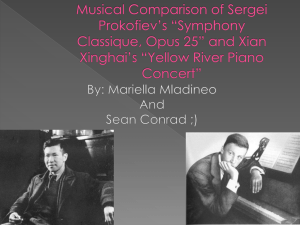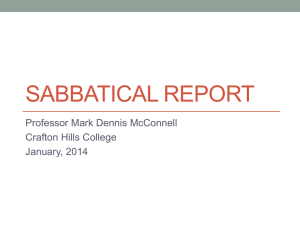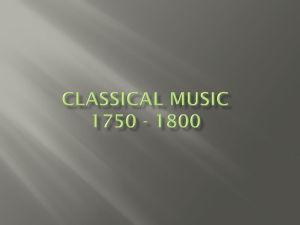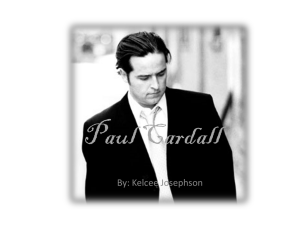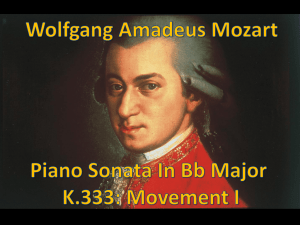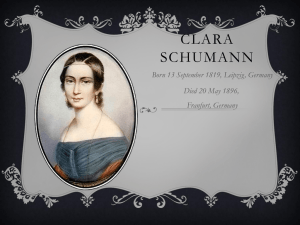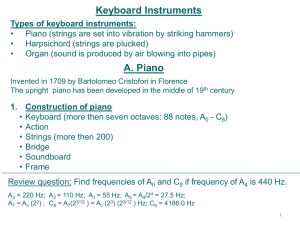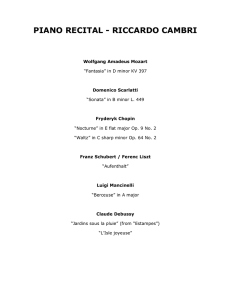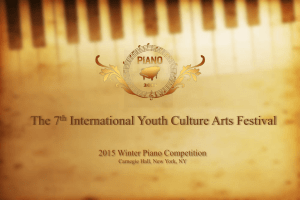Rachmaninoff: Life, Music & Piano Concerto No. 1 Analysis
advertisement
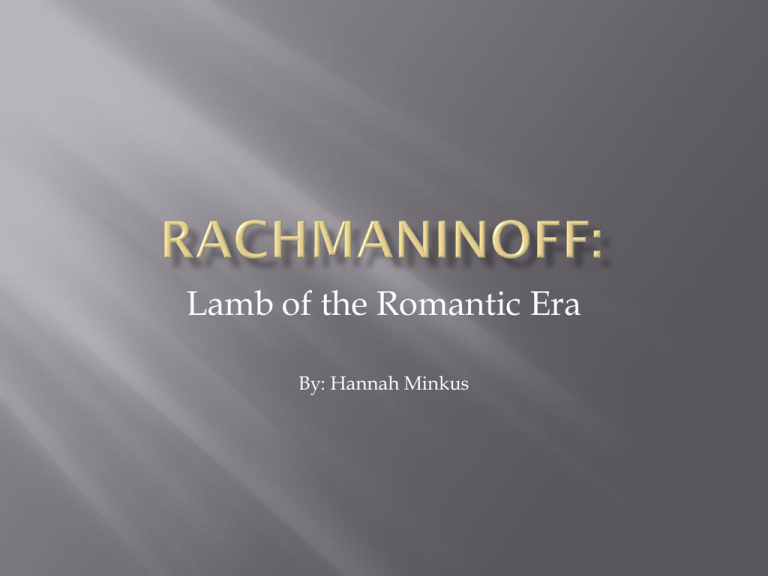
Lamb of the Romantic Era By: Hannah Minkus Life • Details of life are jumbled and conflicting • Born in Russia, 1873 • Wrote over 145 works • • • • Obtained American citizenship Died in U.S. in 1909 Composition not appreciated until after his death Photo (1892) courtesy of Wikipedia Even though his father followed tradition by joining the Russian Army • Sergei’s father Vasily Arkadyevich drank and gambled with his cohorts • Somehow managed to marry a woman of a wealthy background, Lyubof Petrovna Butakova. • They made their home at Oneg, received by dowry. • • • • • 1882 Vasily loses control of finances Family moves to small apartment in St. Petersburg, Russia Sergei moves in with aunt , attends Conservatory on scholarship 1883 Sergei’s sister Sofia dies Vasily leaves St. Petersburg and the family His home life begins to affect him-he becomes lazy in his schoolwork and music studies. Photo courtesy of http://english.ruvr.ru/2006/12/07/115140.html Grandmother brought him to church Elder sister Yelena a talented singer Grandmother buys Novgorod estateSergei enjoys rivers and landscape 19th century gypsy music Russian composers such as Tchaikovsky Photos courtesy of russianorthodox-stl.org and flamecnoaustralia.org Photo Courtesy of uh.edu 1909- Joins New York Philharmonic as solo pianist Shortly after composes Edgar Allen Poe poem into “The Bells” Photo courtesy of Wikipedia Inspires “All Night Vigil” or, “Vespres” Destroys Sergei’s estate Causes him to emigrate to the U.S. Highly regarded Performed Beethoven and Tchaikovsy Free concerts Donations to Allies to fight Nazi regime Helped friends in financial trouble Rachmaninoff overcame Soviet censorship which he earned by signing a letter which condemned the Soviet Regime, becoming “possibly the greatest pianist of the 20th century.” Source: Internet Move Database Piano Concerto No. 1 Written at age 17 Not a very popular piece May reflect his laziness at the time 30 minutes long Comprised of flutes, oboes, clarinets, bassoons, trumpets, trombones, horns, timpanis, strings, and piano Influenced by his Russian heritage, Romantic era music, personal nature (rebelliousness and drama of a 17 year old mind?) Failure of the piece Part of a dark time in Rachmaninoff’s life He seeks help from a hyponotist Pulls out of depression and writes more successful Second and Third Concertos Photo courtesy of 123rf.com Rachmaninoff: “It is really good now… it plays itself so much more easily.” Has since been performed many times- first LA Philharmonic performance in 1960 CD covers courtesy of amazon.com View here (1st part): http://www.youtube.com/watch?v=IhVVQ7_MyJA AND Here (2nd part): http://www.youtube.com/watch?v=hFSfv8MUgIg&feature=related Harrison, Max. Rachmaninoff, Life, Works, Recordings. London: Continuum International Publishing Group, 2006. Howard, Orrin. LA Phil. n.d. June 2011 <http://www.laphil.com/philpedia/piece-detail.cfm?id=484>. Lucid Cafe: Library. 1 January 2011. June 2011 <http://www.lucidcafe.com/library/96apr/rachmaninoff.html>. Internet Movie Database. n.d. June 2011 <http://www.imdb.com/name/nm0006245/bio>. Wikipedia. n.d. June 2011 <http://en.wikipedia.org/wiki/Sergei_Rachmaninoff>. Photos which are not referenced are clip art. • 0:00 Movement begins with strong brass fanfare • 0:17 Piano enters with full and quick descension • • • • • 0:28 Brass re-enters, and piano continues very deliberately 0:37 Brass abruptly ends to give way to piano solo 0:45 Piano slows tempo until a stop at… 0:48 Strings enter with horns, the tempo stays slow with a lilting melody, very romantic 1:17 Piano enters again and plays melody with subtle arpeggios • 1:50 Piano picks up tempo again and begins to very slowly crescendo • 2:11 Reaches small climax, then slow to moderate tempo begins again with arpeggios continuing • 2:36 Strings die down, piano continues in soft tone, very mild timbre • 2:56 Strings enter again with melody and a swaying rhythm • 3:32 Climax begins on piano with ascending notes, in a crescendo • 3:36 Orchestra enters again and leads up to climax • 4:03 A dramatic pause • 4:09 Slow tempo with lilting feeling returns (trills can be heard) • 4:39 Return to climax with allegro tempo • 4:49 Brass/woodwinds and strings (with abrupt tone) echo dramatically • 5:02 Piano enters again in higher pitch with repeating arpeggios • 5:39 Oboe (?) plays, and strings and rest of orchestra gradually enter with melody again • 5:59 Piano enters with strong tone giving way to moderato, then pianissimo • 6:18 Piano begins ascension again with soft texture • 6:30 Orchestra enters again, rhythm is more staccato • 6:55 Slow melody/soft texture begins again, piano playing portion of melody • 7:36 Rest, then fast tempo beings again with high pitch arpeggios from piano in a gradual crescendo • 7:53 Orchestra emphasis, and then piano beings to slow and descend again • 8:40 Orchestra begins with melody and piano continues arpeggios • 9:14 Orchestra climbs to climax with brass and woodwinds playing forte • 9:21 Rhythm changes • 9:28 Cadenza begins… • 10:29 Very soft, dramatic tone from piano • 10:47 Piano begins to play melody beneath arpeggios • 11:11 Piano picks up tempo, lower tones, minor key is strongly evident in lower notes • 11:47 Strings enter abruptly, then join the brass/woodwinds echoing softly • 13:03 Orchestra (strings especially) accent the descension • 13:09 End of movement

